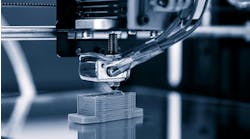Imagine being able to extend a valuable product’s life for another decade. Or the ability to creatively produce parts capable of arising to new performance expectations or the ability to sustainably produce parts on a when needed, where needed basis. In many instances, additive manufacturing makes these scenarios a reality -- adding an important wrinkle to how manufacturers think and produce new parts.
In the case of extending useful life, the ability to 3D print parts required, but not available in the traditional supply chain, is helping keep the Marine Corp’s fleet of nearly 40-year-old Amphibious Assault Vehicles (AAV) operational with the replacement window for the fleet of AAVs still 10 to 15 years away.
As comfort levels improve, opportunities have arisen where the economics support additive’s use, and it is rapidly becoming another tool in the toolbox, explains Tim Weber, global head of 3D materials for HP. “There will also be killer applications, where additive enables manufacturers to make parts that they can't make any other way. People will use it where it makes sense whether it's adding performance or it's a short run and the economics work better.”
Weber tells IndustryWeek, the pandemic brought to light the type of disruptions that regularly occur within supply chains. “The idea of thinking a little bit differently about how you manage your supply chain with something that's much more flexible can make car parts one day and medical parts the next day is monumental,” he says. “What's exciting as additive continues to gain traction, as the world starts to shift, people are waking up wanting to know more about how additive can help convert the parts that make sense economically and from a performance standpoint.”
Unlocking opportunities
Understandably materials play a pivotal role in additive's usefulness. With a focus on helping expand the overall market and unlock new applications for manufacturers, HP is delivering a first of its kind Polypropylene (PP) material for additive manufacturing. The new HP 3D High Reusability PP, enabled by BASF, is a versatile, durable and chemically resistant material that has been qualified for HP’s production-grade 3D printing systems, and is ideal for automotive, consumer, industrial and medical applications requiring an optimal balance between performance and cost. HP also unveiled a new partnership with Oechsler, the global design and manufacturing player, to develop applications for both the new PP and HP’s broader materials portfolio, as well as new customers for its Metal Jet 3D printing technology.
Polypropylene is a versatile material ideal for a wide range of automotive, consumer, industrial, and medical applications. The new HP 3D High Reusability PP enabled by BASF provides customers with a genuine new additive manufacturing material offering the same properties as commonly used PPs in injection molding, which has proven to have nearly unlimited use. PP is ideal for piping, fluid systems, and containers. For example, automakers will be able to use the same PP for prototyping and production of final parts found in vehicles’ interior, exterior and under-the-hood.
“The advancement of our long-standing partnership with HP truly demonstrates our shared vision to help transform industries, enable sustainable production, and enable our customers to shape the Additive Manufacturing industrialization,” said François Minec, Managing Director, BASF 3D Printing Solutions. BASF 3D Printing Solutions unveiled its new Forward AM brand last year as it continues to pursue its goal of driving industrial scalability with future-oriented, leading-edge materials and technology. “The introduction of PP is another important step as we collaborate on best-in-class materials to transform manufacturing. Our teams have worked closely to develop a high quality, sophisticated PP that fully leverages the advanced capabilities of HP’s Jet Fusion 5200 platform – truly a win-win for innovative companies investing in the shift to digital manufacturing.”
“HP and Forward AM by BASF share a deep commitment to accelerating the shift to digital manufacturing by delivering innovative, sustainable solutions and materials that open up entirely new opportunities,” said Ramon Pastor, Interim President of 3D Printing and Digital Manufacturing, HP Inc. “The powerful combination of the world’s leading materials science and most advanced 3D printing capabilities yields superior quality, reliability, workflow, and cost savings for customers. From advanced prototyping to the production of final parts, we are excited about the impact this new PP will have for designers, engineers, and businesses around the world.”
HP is jointly developing entirely new PP applications with partners, parts providers and customers including Extol, specializing in plastics engineering and innovation with industry leading plastic assembly technology, custom automation, and engineering services; GKN/Forecast 3D, a provider of advanced industrial 3D printing, short-run manufacturing, and high-volume production; Henkel, a leader of high- impact adhesives and engineering solutions; Oechsler, a leading additive manufacturing parts provider; and Prototal, one of Europe’s most experienced parts manufacturers.
“Polypropylene is a little bit more of a mainstream material,” says Weber. “Although people will undoubtedly use it for prototyping, it's really an opportunity to get into places where manufacturers are already using polypropylene. Also, this material is much more recyclable both into the normal recycling chain, and in the ability to reuse all the powder.”Reaching new heights
HP also unveiled a variety of new professional services capabilities including design optimization for breakthrough applications, manufacturing process streamlining to enable mass customization and scale production, and applications identification and discovery services.
“Our professional services will play a key role in helping companies move on from the prototyping mentality. When creating a new part, engineers design it to fit specific processes, whatever it is investment casting, stamping, forging, CNC or additive,” says Weber. “There are design rules they need to understand and apply. When our application and design engineers are part of the conversation, they can work with customers to figure out how do you optimize parts.”







